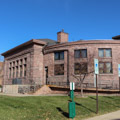You are here
Carnegie Town Hall
Sioux Falls, South Dakota’s largest city, was the first in the state to secure funds for a Carnegie library. The city received a $25,000 grant in 1901 and hired local architect Joseph Schwarz to design the library, which opened in 1903. Built of purple Sioux quartzite cut from a nearby quarry, the one-story structure sits on a raised basement. Its shape consists of a rectangular volume with a semicircular apse at the rear, which served as the reading room. The rough-cut stone, recessed window openings, and overall massing are Richardsonian Romanesque, but the pedimented entrance supported by pilasters and the dentiled cornice reflect the Classical Revival style adopted in so many of the Carnegie library designs.
The building was used as the library until 1972. It was then home to the Civic Fine Arts Association until 1999. In 2001 the City of Sioux Falls rehabilitated the structure for use as the Carnegie Town Hall, which houses the Sioux Falls City Council Chambers, the City Clerk’s Office, and the Community Development Office.
References
Writing Credits
If SAH Archipedia has been useful to you, please consider supporting it.
SAH Archipedia tells the story of the United States through its buildings, landscapes, and cities. This freely available resource empowers the public with authoritative knowledge that deepens their understanding and appreciation of the built environment. But the Society of Architectural Historians, which created SAH Archipedia with University of Virginia Press, needs your support to maintain the high-caliber research, writing, photography, cartography, editing, design, and programming that make SAH Archipedia a trusted online resource available to all who value the history of place, heritage tourism, and learning.









